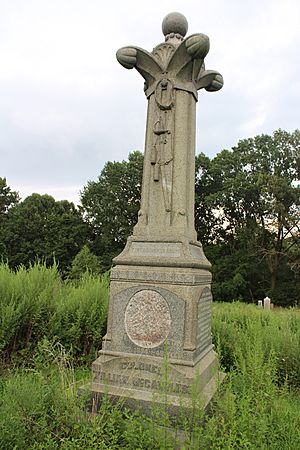William McCandless facts for kids
Quick facts for kids
William McCandless
|
|
|---|---|
| Nickname(s) | Buck |
| Born | September 29, 1834 |
| Died | June 17, 1884 (aged 49) |
| Buried |
Mount Moriah Cemetery
|
| Allegiance | United States Union |
| Service/ |
United States Army Union Army |
| Rank | |
| Unit | 2nd Pennsylvania Reserve Regiment Pennsylvania Reserve Division |
| Battles/wars | American Civil War |
| Other work | State Senator |
William McCandless (September 29, 1834 – June 17, 1884) was an important American soldier and politician from Pennsylvania. He fought for the Union Army during the American Civil War. He led a large group of soldiers called a regiment, and later a bigger group called a brigade, in the Pennsylvania Reserve Division. After the war, he became a Democratic politician. He was a member of the Pennsylvania State Senate from 1867 to 1868. He also became the first Secretary of Internal Affairs of Pennsylvania, serving from 1875 to 1879.
Contents
Early Life and Education
William McCandless was born in Ireland on September 29, 1834. His nickname was "Buck." When he was a young child, his parents passed away, and his uncle raised him.
When William was six years old, his family moved to Philadelphia, Pennsylvania. He went to public schools there. He also learned to be a machinist at Norris Locomotive Works, which made trains. Later, he studied law and became a lawyer in 1858.
Military Service in the Civil War
McCandless joined the 2nd Pennsylvania Reserve Regiment as a private soldier. But he quickly moved up in rank. In June 1861, he became a major. By August 1862, he was promoted to colonel, leading the entire regiment.
His regiment fought in many big battles. They were part of the Army of the Potomac and saw action in the Seven Days Battles. They also fought at the Second Battle of Bull Run and the Battle of Antietam. McCandless was hurt at Second Bull Run and could not fight at Antietam.
Leading Soldiers in Battle
During the Battle of Fredericksburg, another commander, William Sinclair, was wounded. McCandless then took charge of the 1st Brigade of the Pennsylvania Reserves. This group was part of the I Corps, led by George Gordon Meade. They managed to break through the Confederate lines during the battle.
After Fredericksburg, the division moved to defend Washington, D.C.. They needed time to rest and recover from their heavy losses.
Gettysburg and Beyond
In May 1863, McCandless's division returned to the main Union Army. They became the 3rd Division of the V Corps. McCandless continued to lead the 1st Brigade. He played an important role in the Battle of Gettysburg.
On the second day of the battle, July 2, 1863, McCandless moved his soldiers to the army's left side. They set up in two lines near Little Round Top. His brigade, with help from another group, launched a counterattack against the Confederates. They pushed the enemy back across Plum Run Valley and up towards the Wheatfield. McCandless's brigade held their ground for the rest of the battle. On July 3, they advanced and gathered up Confederate soldiers who were retreating.
McCandless briefly commanded the entire division in the fall of 1863 during the Bristoe Campaign. He then went back to leading his brigade under Samuel W. Crawford in the Mine Run Campaign.
He continued to lead his brigade in Ulysses S. Grant's Overland Campaign. McCandless was wounded again in the Battle of the Wilderness. Grant and Meade offered him a promotion to brigadier general, but he chose not to accept it. Colonel McCandless left the volunteer service with his regiment on June 6, 1864.
Life After the War
After the Civil War, William McCandless went back to Philadelphia. He continued his work as a lawyer.
Political Career
McCandless also became involved in politics. He was a member of the Pennsylvania State Senate for the 1st district from 1867 to 1869.
In 1874, he was elected as the first Secretary of Internal Affairs of Pennsylvania. He served in this important state role from 1875 until 1879.
William McCandless passed away on June 17, 1884. He was buried at the Mount Moriah Cemetery in Philadelphia, Pennsylvania.



